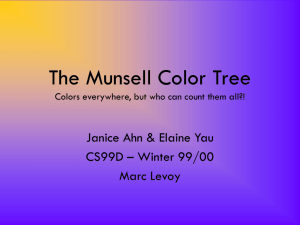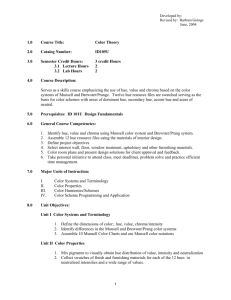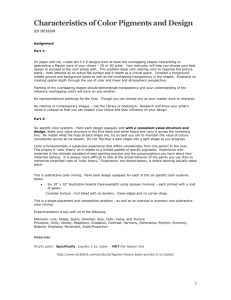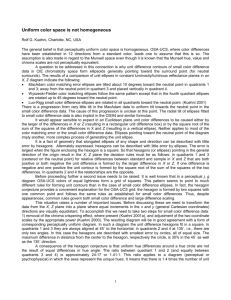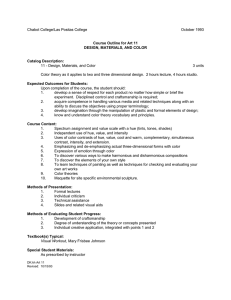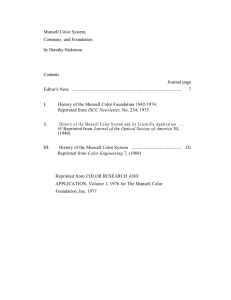Munsell Presentation
advertisement
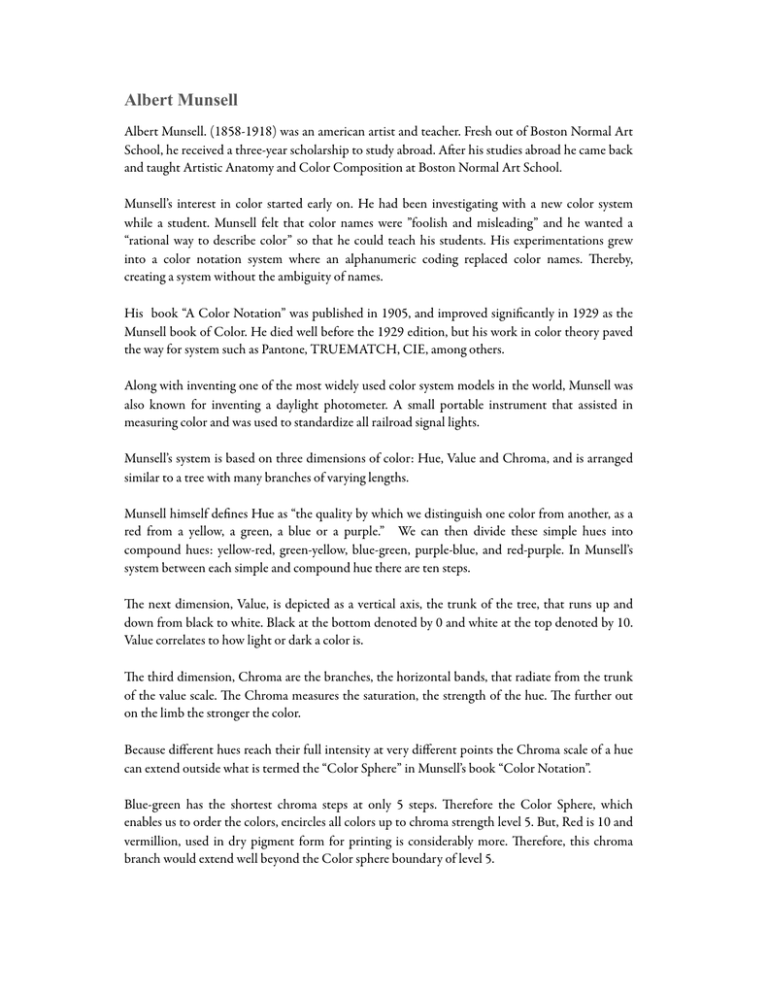
Albert Munsell Albert Munsell. (1858-1918) was an american artist and teacher. Fresh out of Boston Normal Art School, he received a three-year scholarship to study abroad. Aer his studies abroad he came back and taught Artistic Anatomy and Color Composition at Boston Normal Art School. Munsell’s interest in color started early on. He had been investigating with a new color system while a student. Munsell felt that color names were ”foolish and misleading” and he wanted a “rational way to describe color” so that he could teach his students. His experimentations grew into a color notation system where an alphanumeric coding replaced color names. ereby, creating a system without the ambiguity of names. His book “A Color Notation” was published in 1905, and improved significantly in 1929 as the Munsell book of Color. He died well before the 1929 edition, but his work in color theory paved the way for system such as Pantone, TRUEMATCH, CIE, among others. Along with inventing one of the most widely used color system models in the world, Munsell was also known for inventing a daylight photometer. A small portable instrument that assisted in measuring color and was used to standardize all railroad signal lights. Munsell’s system is based on three dimensions of color: Hue, Value and Chroma, and is arranged similar to a tree with many branches of varying lengths. Munsell himself defines Hue as “the quality by which we distinguish one color from another, as a red from a yellow, a green, a blue or a purple.” We can then divide these simple hues into compound hues: yellow-red, green-yellow, blue-green, purple-blue, and red-purple. In Munsell’s system between each simple and compound hue there are ten steps. e next dimension, Value, is depicted as a vertical axis, the trunk of the tree, that runs up and down from black to white. Black at the bottom denoted by 0 and white at the top denoted by 10. Value correlates to how light or dark a color is. e third dimension, Chroma are the branches, the horizontal bands, that radiate from the trunk of the value scale. e Chroma measures the saturation, the strength of the hue. e further out on the limb the stronger the color. Because different hues reach their full intensity at very different points the Chroma scale of a hue can extend outside what is termed the “Color Sphere” in Munsell’s book “Color Notation”. Blue-green has the shortest chroma steps at only 5 steps. erefore the Color Sphere, which enables us to order the colors, encircles all colors up to chroma strength level 5. But, Red is 10 and vermillion, used in dry pigment form for printing is considerably more. erefore, this chroma branch would extend well beyond the Color sphere boundary of level 5. As well, colors do not reach their maximum chroma strength at the same value level, think of the vertical greyscale axis. For example, yellow’s strongest pigment is of a higher Value, lighter, than blue’s strongest pigment. erefore, the chroma paths will touch the vertical greyscale value axis at different points on this scale. An example of the notation system may look like this: R 5/10 R = Hue = Red 5/ = Value scale = where the hue falls on the greyscale vertical axis. /10= Chroma scale = e strength of the color. In this case, the hue is Red at its strongest point. (aside from vermillion as mentioned above) Once you understand the elements, hue value and chroma, you can put the formula together to figure out the alphanumeric value of any hue. Munsell’s system eliminates the need for subjective names and confusing responses to questions like, “what color red is that?”. e Munsell Color system enables anyone to quickly understand how to balance colors by simple calculations. For instance, let’s take red and it’s opposite bluegreen on Munsell’s color scheme. In order to balance these colors we must use blue-green at it’s strongest chroma, 5, with red at it’s middle chroma of 5. In essence, we chopped off the red branch at the chroma branches’ 5th step. is is a simple solution. But at times we may want to balance colors of weaker and stronger chroma on different value levels. Logic dictates we will use a larger area of the weaker color with a smaller area of the stronger color. An example of how to do this follows: Say let’s use yellow Y 7/9 A very high value and chroma - bright yellow. with purble-blue P-B 3/4 , a low value low chroma hue. If we multiply 7/9 (7 x 9 = 63) and we multiply 3/4 (3 x 4 = 12). We derive at the numbers that corresponds to the amount of each hue. However, we inverse the number with the hue. In conclusion, we will use 63 parts of P-B to 12 parts of Y. Highlight 3-5 discoveries, research and contribution of the color theorist. • Created the first standard Color Model used today in the Arts, Design, Education, Environmental studies, Geology, Interior design, Industrial, Food Products, Product Development, Government standards, Pharmaceutical, Safety, Archeology • Created a system using Alphanumeric notations eliminating the naming of colors • Created a Portable Day Photometer that was used to standardize the railroad Yellow signal • Paved the way for the Pantone system Visuals of Albert Munsell’s Color Model System My Interpretation of Munsell’s Color System Dimension 1: 10 Step Hue scale: Red, Red-Purple, Purple, Purple-Blue, Blue, Blue-Green, Green, GreenYellow, Yellow, Yellow-Red Dimension 2 and 3 Yellow Tree - with Value Scale Trunk and Chroma Branches Dimension 2 and 3 Purple Tree - with Value Scale Trunk and Chroma Branches

